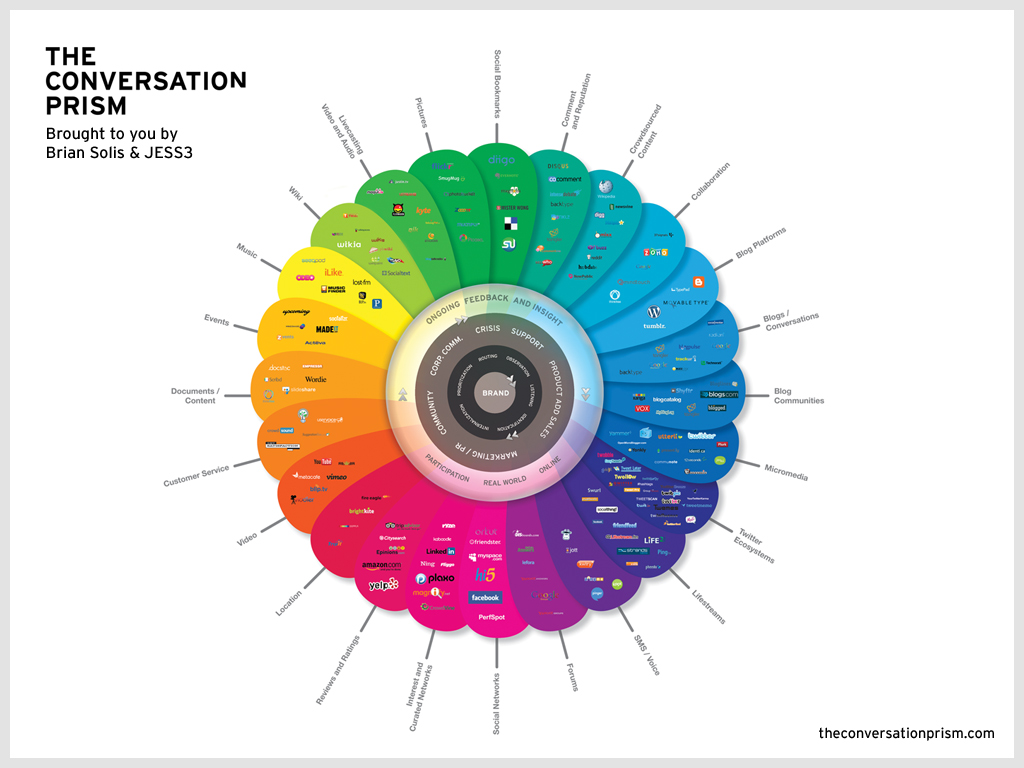Here is a presentation on vital 6 Elements of Your Social Media Strategy to keep you and your staff on track. No matter where you are in your online marketing, whether you’re just getting started or are a veteran, it helps to have a reminder.

Image Credit : Google
1) Who is your audience?
Where do you start when it comes to a social media strategy? How do you begin a strategy when you’re not sure where to start? That’s what this series of articles will step you through: what you need to know so you can develop an effective social media strategy for your business. Your plan will look widely different from others taking this same course, because their business is unique from yours. No two strategies will be exactly alike.
2) What are your goals?
You wouldn’t think of starting a business without a plan, would you? What about your marketing strategy? It’s critical that you identify goals for your social media strategy, because they will drive every decision you make, every tactic you use, and all the research you do.
3) Where are your customers in the social media landscape?
What tools do they use? Let’s briefly review the most popular social media platforms and who you can reach using them:
Blogs
Readers tend to be under 45, but more seniors are catching on. Blogs, along with video, are the best way to increase your Google search engine ranking, and a fabulous method for reaching out to both new and existing customers. Be prepared though: blogs take time to do well and consistently. What do we recommend as blogging platform with hosting? You should have
WordPress with Dreamhost. Awesome customer service which is very important if you face any issue.
Email Newsletters
The deepest content channel of them all, they are great for reach existing customers and telling them what’s new with your business. Also great for educating customers because you have the space to do it. Key advantage of email newsletters is they appear in your customer’s inbox, but be savvy about your subject line, as Google’s Gmail is a tough spam blocker and often blocks credible content. I use iContact for their ease of use and superior customer service.
Facebook
Everyone is here, period. Whether you love or hate Facebook, if you do business with the general public, you need a Facebook page. On your wall, don’t make the mistake of hitting people over the head with a hard sell: give them helpful information that makes their lives better and relates to your product. The fastest growing demographic on Facebook? Females over 55. Best time to post on Facebook? 6-11p.m., when people are at home and spending leisure time on the internet.
Twitter
Micro-blogging in under 140 characters. Twitter is huge in metropolitan areas, for B2B networking, and for under 40 demographic. Excellent for restaurants. Upscale mobile taco stands in Los Angeles have customers lining up when they let them know their location for the day. Rural areas? Forget it.
YouTube
The second most-visited search engine, behind Google. If you don’t have a YouTube channel, you are missing out on customers, period. Your videos don’t have to be slick or expensively produced. Authentic is the new black. Get a Flip video camera and upload your own videos without breaking the bank. Great for new and existing clients, and people can subscribe to your videos, automatically getting new ones.
LinkedIn
Great for B2B networking and catching up with colleagues. After every in-person meeting you have professionally, make sure to connect via this social network. LinkedIn is a great platform to establish credibility by answering questions and find online groups in your niche.
4) When do you plan on communicating with your customers?
How often? Do you currently have an advertising schedule that clearly defines when you advertise and in what publications? Start there.
Think in terms of your business calendar, and identify the seasonal nature of your product. If you’re an accountant, then April and October will be your busy periods, and you need get in touch with customers before those months. If you are a retailer, your merchandise changes with the seasons, and you want to let your customers know about your changing inventory.
5) Why should customers choose your company?
What’s in it for them? Identifying the why in your social media strategy is often the toughest step, because it requires you to really differentiate your products from all the rest and tell why you’re special. Word to the wise? Don’t do it by belittling the competition: negativity only makes you look bad. Example? Negative campaign ads. When was the last time you felt good about voting for a candidate? If you and your competition spend too much time pointing out each other’s negatives, you both look bad and no one wins. You want loyal, raving fans.
 6) How will you reach your clients?
6) How will you reach your clients?
What tactics will you use? How will you incorporate the previous 5 W’s into your strategy? Here are several best practices for how to reach your customers via social media:
- No amount of outstanding social media will overcome poor quality products and services. Before you invest in online promotion, ensure you offer superior quality. Social sharing makes it simple to spread the word, and you want positive news being shared about your company.
- Educate instead of resorting to the hard sell. Once consumers feel you are competent, qualified, and trustworthy, they want to learn from you. Teach them.
- Give people a sample of your company by offering something for free in exchange for their contact information. I offered a free first chapter of my book, Color Mastery, and at the time I was the only one in my industry doing it. Readers could figure out whether my book was for them and where they could buy it.
- Make it easy to contact you and buy your product. Put your telephone number on every page of your website, along with all of your social network links. If you make it difficult to get in touch with you, people won’t, period.
- Incorporate your social media into every aspect of your business. Put your social network information on your receipts, invoices, and every printed marketing material you use. Have salespeople in the store remind buyers they can find you online and encourage them to do so.
- Give people an incentive to join your social network. Offer incentives, exclusives, or other special promotions exclusively for your email newsletter subscribers, Facebook fans, and Twitter followers.












![How Social Media Helps In Recruiting [Infographic] How Social Media Helps In Recruiting [Infographic]](https://blogger.googleusercontent.com/img/b/R29vZ2xl/AVvXsEhEfzRJpEZ9IwAzRIf88W9BctUB8dRJhW4vTC5uK0fs-K9fClcDVsyZtx_gc0PU5TOFMvEp30CHYaDdOjlBKYpl82z1GQjTfFBKSnBKPkxXH3F2s2MhdYVQaDsJItw1jTAlDaMarg-h1PNP/s640/social-media-recruiting.jpg)

![How Much Data Is Generated In One Minute [Infographic] How Much Data Is Generated In One Minute [Infographic]](https://blogger.googleusercontent.com/img/b/R29vZ2xl/AVvXsEg3nZFAlE7wKqxg09twjHjkSvyXLRLRNBiL-tF1T3kx9TALd_tAN2gNwP_ABkzXXg1MatDQJNjBFjF-xEd-_Bowrvd-vznx3aGhPjJAZse1JmJEyAYCo1Prm7ZZRnTIsLnyWRzZvAs0sKvT/s640/data-in-one-minute.jpg)

![Digital Acquisitions & Mergers Between Most Prominent Businesses [Infographic] Digital Acquisitions & Mergers Between Most Prominent Businesses [Infographic]](https://blogger.googleusercontent.com/img/b/R29vZ2xl/AVvXsEicerjMF-2F609BNTOfop0JUHoFNIJ7qNvBm35zKFcwHyQUHF7eriLTCPCWRdCPzX4J2yjf0jXATzDoSbo2pQ_OrDBBeiDo5pBSi6KDJtb-Gs1iLDbtbIP5McBdTu9EMnukft_EOzbZfPwy/s640/mergers-and-acquisitions.jpg)

![How Safe You Are Online [Infographic] How Safe You Are Online [Infographic]](https://blogger.googleusercontent.com/img/b/R29vZ2xl/AVvXsEjk-mpwOD48JDRL4bMBXgTOlXR_FdqQGAAuZWrktt7RmFrbQpS7Da_hcCZT_oiPpgFEFDjq1l4IYpwYbLTwY-MQJjaiJILAVs47vP4I7b76btKgB3kJWkzrCeyua0FX9IG2prYueYbtxYhb/s640/are-you-safe-online.png)
![Building Brand Advocates [Infographic] Building Brand Advocates [Infographic]](https://blogger.googleusercontent.com/img/b/R29vZ2xl/AVvXsEgTrbCo6hlBZb1lK4nnDlAl7VxCd_hh62vpOLL2V1dR9rsx4u11HjefJhragimYzW3hyeUjJLzkQ0Q-0DAE7HQoYHOOse3kpaHgIvG-Il45RHTskGW7msfBxevb66OCW-zHcjlSR5U1No_d/s640/building-brand-advocates.png)




![Top 10 Restaurants In Social Media [Infographic] Top 10 Restaurants In Social Media [Infographic]](https://blogger.googleusercontent.com/img/b/R29vZ2xl/AVvXsEhO4Nw32POP1Zg737plrg0yKE3fO9QzZCEVoSl3P87GxIvpbYW1TVLI_1BuaMrUopnx7_b7tel0Ewti6-ZY4kqlQx6euidKEkBXsyDvCuzFqsUbQF-3pYaoz_zpEpDtmmvrC5oi83csw-GZ/s640/top-10-restaurant-social-media.png)


![The Evolution Of Business Cards [Infographic] The Evolution Of Business Cards [Infographic]](https://blogger.googleusercontent.com/img/b/R29vZ2xl/AVvXsEiTrdAeW4IPQQp2OmBkFm9HYWOQmueALVDlbC0MGuPFEwanadLWumFv7PsuNfOJgwEoeULbCCmIu_o0t7z_VcwYoS8y3IxZW9sKiwKIkvs3-0jfUqdRgYCJUbbw1xMX_OtzNY4Qu1z11trb/s640/the-evolution-of-business-cards.jpeg)



![How To Develop Social Media Marketing Strategy [Infographic] How To Develop Social Media Marketing Strategy [Infographic]](https://blogger.googleusercontent.com/img/b/R29vZ2xl/AVvXsEhRBgiRu6SHdNYunuHK-3Wzc58qjCFxUcTSztEw9QbTDDKONdmWt-6Ks9RDCBD4ES1ROKVSfLmWX1iJr5_1V8Bl0ef3jVXQge48xK3lKbz991CmxnFo-te3F-0L_kHR0aAxO6NORSpHKWWg/s640/Social-Media-Strategy.png)





















 Recent
Recent Tags
Tags Popular
Popular




